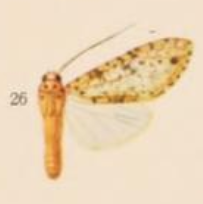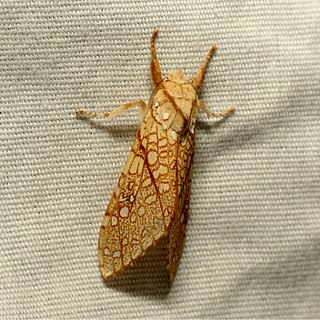
Lophocampa montana is a moth of the family Erebidae. It was described by William Schaus in 1911. It is known from Poás Volcano in Costa Rica.

Lophocampa distincta, is a moth of the family Erebidae. It was described by Walter Rothschild in 1910. It is found in Peru, Brazil, Argentina, Colombia and Ecuador.

Lophocampa alsus is a moth of the family Erebidae. It was described by Pieter Cramer in 1777. It is found in Suriname and possibly Colombia and Venezuela.

Lophocampa atriceps is a moth in the family Erebidae. It was described by George Hampson in 1901. It is found in Colombia, Ecuador (Guayas) and Costa Rica.

Lophocampa albipennis is a moth of the family Erebidae. It was described by George Hampson in 1904. It is found on the Bahamas.

Lophocampa amaxiaeformis is a moth of the family Erebidae. It was described by Walter Rothschild in 1910. It is found in Panama and Ecuador.

Lophocampa annulosa, the Santa Ana tussock moth, is a moth of the family Erebidae. It was described by Francis Walker in 1855. It is found in southern Texas, southern Arizona, Mexico, Costa Rica, Ecuador, Venezuela, Peru, Suriname, Brazil, Argentina and Trinidad.
Lophocampa arpi is a moth of the family Erebidae. It was described by Paul Dognin in 1923. It is found in Brazil.

Lophocampa atomosa is a moth of the family Erebidae. It was described by Francis Walker in 1855. It is found on Jamaica and Cuba and in Ecuador.

Lophocampa dognini, the Rothschild's marbled tiger, is a moth of the family Erebidae. It was described by Walter Rothschild in 1910. It is found in Peru.

Lophocampa endolobata is a moth of the family Erebidae. It was described by George Hampson in 1901. It is found in Brazil.

Lophocampa endrolepia is a moth of the family Erebidae. It was described by Paul Dognin in 1908. It is found in Ecuador.

Lophocampa grotei is a moth of the family Erebidae. It was described by William Schaus in 1904. It is found on Cuba.

Lophocampa longipennis is a moth of the family Erebidae. It was described by Paul Dognin in 1908. It is found in Bolivia.

Lophocampa mixta is a moth of the family Erebidae. It was described by Berthold Neumoegen in 1882. It is found in the United States in Arizona, Texas

Lophocampa modesta is a moth of the family Erebidae. It was described by William Forsell Kirby in 1892. It is found in Costa Rica, Panama, Suriname, Ecuador, Bolivia, Peru and Venezuela.
Lophocampa nimbifacta is a moth of the family Erebidae. It was described by Harrison Gray Dyar Jr. in 1912. It is found in Mexico.
Lophocampa pectina is a moth of the family Erebidae. It was described by William Schaus in 1896. It is found in Mexico.
Lophocampa russus is a moth of the family Erebidae. It was described by Rothschild in 1909. It is found in South America, including Peru.
Lophocampa oblita is a moth of the family Erebidae described by Benoit Vincent in 2009. It was described by Max Gaede in 1923 under the name Halisidota fasciata. It is found in Bolivia.
















